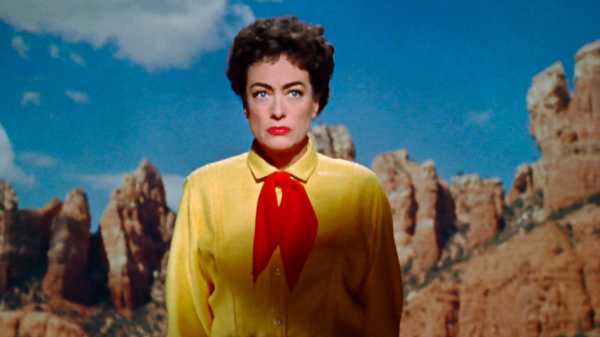
The Western is the prime political genre, and Nicholas Ray’s “Johnny Guitar,” from 1954, is one of the greatest Westerns, but its political ideas are hardly the source of its enduring—and controversial—power. What makes the movie is the performances by its lead actors, Joan Crawford and Sterling Hayden, which are different in kind from any others that I’ve seen, including by those actors elsewhere. Performances are always connected to direction, but the ones in “Johnny Guitar” appear even more so—in terms of the composition of images, the positioning of actors relative to one another and to the décor, and, above all, the movie’s general tone—than literally any Hollywood movie I know, including such epochally inventive ones as “Citizen Kane” and “Vertigo.” Without any intellectual palaver, metafictional games, or reflexive winks, “Johnny Guitar” is a theory of cinema in motion.
Even in the studio world of seductive artifice, “Johnny Guitar” stands out; it achieves an unmatched height of stylized behavior. (It is screening, in a 35-mm. print, at Roxy Cinema from Wednesday through Saturday, and is also widely available streaming.) The film is a sort of cinematic opera in which scenes have the force of arias, in which dialogue less advances the action than it adorns the movie like bruising and vulnerable lyric poetry, in which the framing of actors forms a unique visual music—even unique in the career of its director, Nicholas Ray, who made many enduring classics (such as “In a Lonely Place” and “Rebel Without a Cause”) but nowhere else reached the singular intensity and stylistic purity of “Johnny Guitar.” It’s among the very heights of what the Hollywood system, for all its distortions and exclusions, was capable of—and, even more important, it represents the furthest extreme that the star system could produce, or allow.
The exceptional status of its art has also been the cause of exceptional misunderstandings. (The Times called it a “fiasco”; in Variety, Ray and the film’s screenwriter, Philip Yordan, were criticized for emphasizing “character nuances and neuroses” in lieu of plot. In The New Yorker, John McCarten called it “the maddest Western you are likely to encounter this year” and, bewildered by its female gunfighters, decreed, “Back to Kinder, Küche, Kirche.”) The movie was a star-driven vehicle: Crawford acquired the rights to the story on which it was based, and she demanded changes to the screenplay in order to make her character the center of the drama. Ray (who also produced the film, albeit uncredited) and Yordan, who’d collaborated closely on the script, were forced to rewrite it on the fly, during the shoot. The result is a script that develops the clear and stark drama on an extraordinarily loose and seemingly impulsive array of flourishes and fillips, rhetorical sallies and filigreed side business.
Crawford plays Vienna, who owns a lonely outpost of a saloon and gambling house, Vienna’s, outside a small Western town. Its value is in the future, though—the railroad will be coming through and will turn the settlement into a boom town. A big-time rancher, known only by his last name, McIvers (Ward Bond), and the local banker, Emma Small (Mercedes McCambridge), covet Vienna’s land and are conspiring to drive her out of business and out of town. When a stagecoach is held up nearby (and Emma’s brother is killed), they falsely accuse Vienna’s lover, a fast-drawing gunslinger called the Dancing Kid (Scott Brady), and his trio of cohorts of the crime—and they accuse Vienna of being in on the conspiracy. An outsider shows up at Vienna’s—the titular character (Hayden), an even faster gunman and Vienna’s ex-lover, whom she has summoned from Albuquerque for additional protection.
The movie’s politics are conspicuous and defiant. There are allusions to McCarthyite inquisitions and persecutions (both Ray and Hayden had been subpoenaed by the House Un-American Activities Committee, and Yordan sometimes served as a front for blacklisted writers) and to legalized misrule by the wealthy; there are denunciations of mobs and ambient terror of lynchings. The constant and central politics are gender-based, with men bemoaning their diminished status beside powerful women and women demanding and asserting their equality nonetheless (including in sexual relations)—ultimately leading to a celebrated climactic showdown between Emma and Vienna.
What “Johnny Guitar” offers above all is a concentrated force of style in action, even during the extended early set piece: the confrontation in Vienna’s. As Emma, McIvers, their posse of townsmen, the Dancing Kid, and his three cohorts all reach for their guns, Johnny steps into action—with a gesture. A slammed-down shot glass is about to roll off the bar, and Johnny steps in to catch it in midair, with his hand cupped backhand. This dance-like deftness also conveys his gunslinger’s alertness—he won’t turn his back on any of the other gunslingers or let them out of his sight.
Yet Mr. Guitar, for all his wiles, is, to all appearances, not a gunman—he bears no arms but only, yes, his guitar, which he has deposited on the bar for safekeeping. His way of defusing the imminently violent confrontation has the kind of pulp grandeur that, fused with Hayden’s performance and Ray’s compositions, outleaps its commercial framework to latch onto high-cultural exaltation. While holding a fine-china coffee cup, Johnny asks the Dancing Kid for a cigarette and McIvers for a light, drawing his requests out to a faux-amiable amble. He adds a folksy yet bombastic monologue, about the vanity of covetousness, and concludes with an ironic flourish of Tolstoyan inspiration: “When you boil it all down, what does a man really need? Just a smoke and a cup of coffee.” Hayden delivers the monologue in a papery baritone that alternately lags behind the beat and rushes ahead, and caps it off with a puff of a cigarette that he lowers like a sceptre. He has the improvisational cool and the knowing reserve of a jazz musician; he and Ray flaunt the incongruity of the tone, and Ray underlines it in the stunned stillness of other characters’ reactions and the stifled smirk of Tom (John Carradine), Vienna’s devoted majordomo. Yet the edifying humor quickly gives way to an even wilder strangeness when the Kid and Johnny lock horns in front of the assembled crowd and, again, the unarmed Johnny defuses the situation: they mock each other’s names and, instead of a fight, Johnny smirkingly plays a bouncy tune on the guitar and the Kid grabs the bereaved and bewildered Emma for a dance while everyone, trigger fingers itching, looks on in hypnotized wonder.
It would be inaccurate to reduce “Johnny Guitar” to such isolated moments of unparalleled power. The movie is full of felicities, whether in the regal authority with which Vienna runs her saloon and faces down mobs, the disturbing outburst of violence with which Johnny reveals his hidden talents, in its terrifying depictions of the cruel deeds and the cruel fates that go with life out West, or in such sharply perceived minutiae as the chilling rattle of Vienna’s roulette wheel or the fluttering of Emma’s veil of mourning into the dust of the trail. As Emma, McCambridge is as idiosyncratically frenetic as Crawford and Hayden are tightly controlled. Ray collaborated with the cinematographer Harry Stradling to create a screeching, acidulous palette of yellows, reds, and greens that stand out all the more against Ray’s calculated array of black-and-white outfits. But for all the film’s outrageous, exaggerated modes of expression, Ray makes sure to stamp the film with high cultural import—not least in the very name of Vienna, its female protagonist, and in her own inclinations and range of references. Her saloon has no mere beaten-up upright piano but an elegantly carved square grand, which Vienna herself, in a ballroom gown, plays in the classical manner for her own pleasure.
Stillness is the principal trope of “Johnny Guitar.” For all the movie’s cruel and violent and rowdy action, Ray invests its finest scenes with a monumental immobility that emphasizes the explosive passion roiling within. “Johnny Guitar” is also a love story of interlocking broken triangles: Emma loves the Dancing Kid, who loves Vienna, who loves Johnny but, although Johnny loves Vienna, too, she doesn’t trust him enough to rush back into romance with him. Vienna dismisses the Kid and welcomes Johnny back in a sequence that drips with a combustible blend of innuendo, derision, contempt, and depth of mutual understanding. The scene in which Vienna and Johnny confront each other, five years after their breakup, and vent at each other, unleashing their rage and pent-up pain alone together in the middle of the night, is the one that, hand to fire, I’d offer as the greatest movie acting—and the greatest image of movie acting—I’ve ever seen. It’s not a long scene, nor does it embrace a wide range of expression, but it’s the most compressed and condensed one that I know. The framing, the lighting, the pacing, the rhythm of the editing are inseparable from the overwhelming power of the performances. It’s the scene I’d show as the very definition of movie acting as opposed to theatre acting—the very essence of cinematic performance.
Vienna finds Johnny drinking alone in the middle of the night in a back room of the saloon. He’s in despair over his macho pride, flinging at her an insulting question: “How many men have you forgotten?” She responds defiantly, “As many women as you’ve remembered.” He leaps to his feet and pleads, “Don’t go away”—and Vienna responds with a line that Crawford emphasizes in her performance and that Ray reinforces with his direction: “I haven’t moved.” He beseeches her again: “Tell me something nice. . . . Lie to me. Tell me all these years, you’ve waited.” She tells him. I won’t spoil it, but she does so in a closeup in which the contrast between her presumed lies and the emotion behind it is almost unbearably great; it highlights the laser-like power of her fixed gaze and thrusts the cut-glass sharpness of her diction to the fore. Her stillness, fused with that of the image, is here pushed to the extremes at which that which freezes also burns, as if generating heat via pressure. In 1996, I sat in the fifth row of the Metropolitan Opera as Jessye Norman sang the starring role in Leoš Janáček’s “The Makropulos Case,” and, as she sang a climactic passage, I felt as if I could actually feel my eardrums vibrating with the focussed volume and pure pitch. Nothing else in movies, beside Crawford’s acting in this scene, gives me that same feeling. ♦
Sourse: newyorker.com






